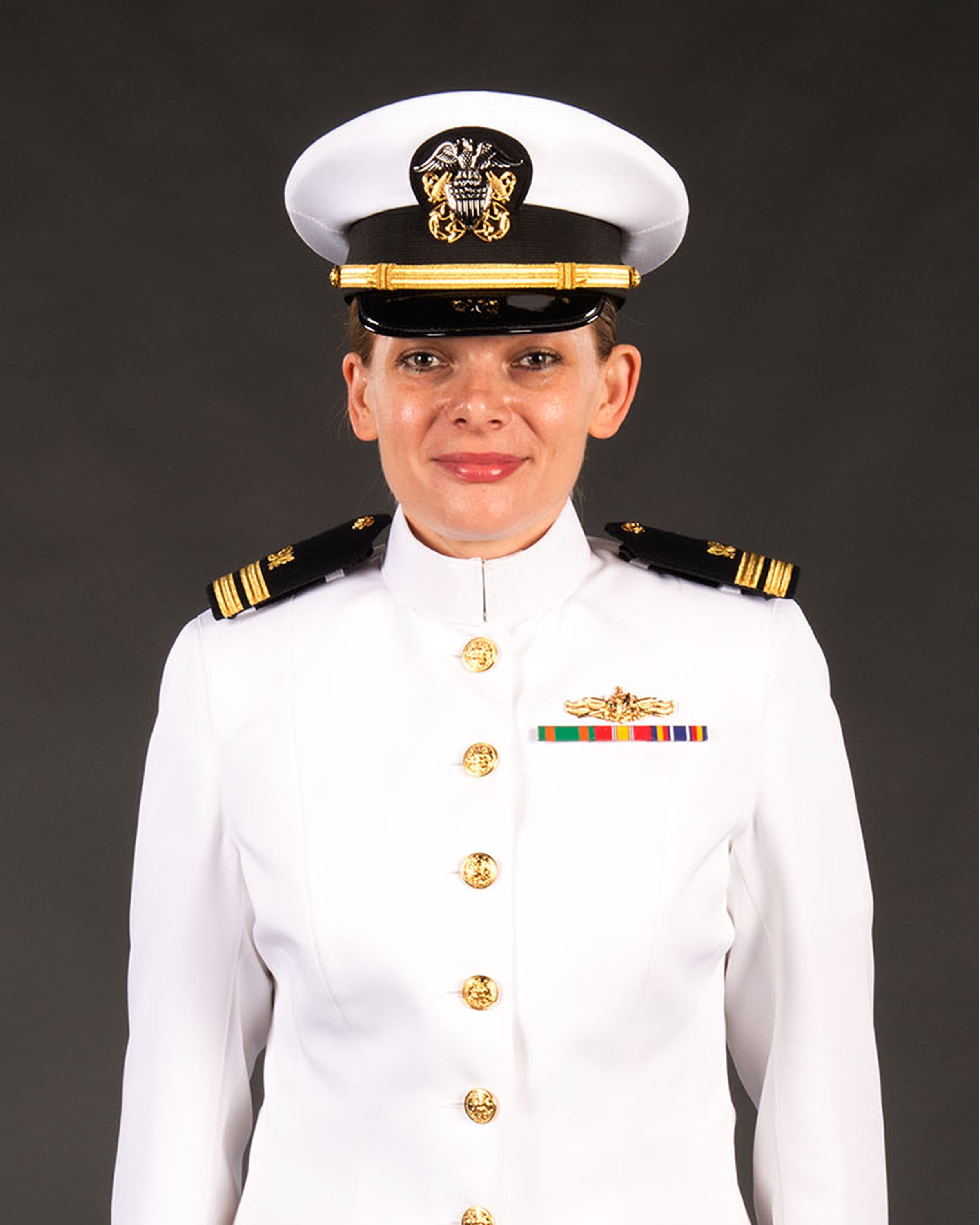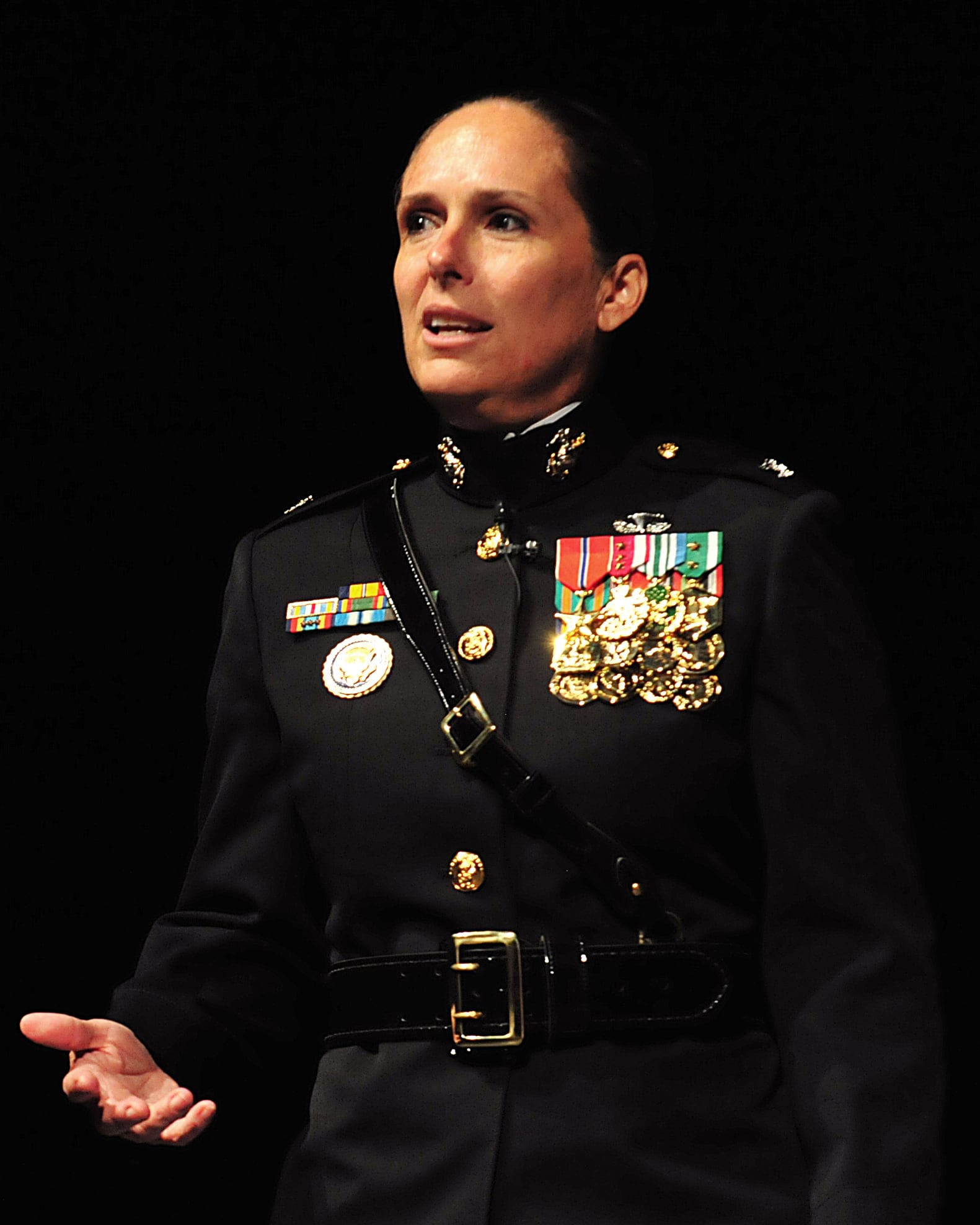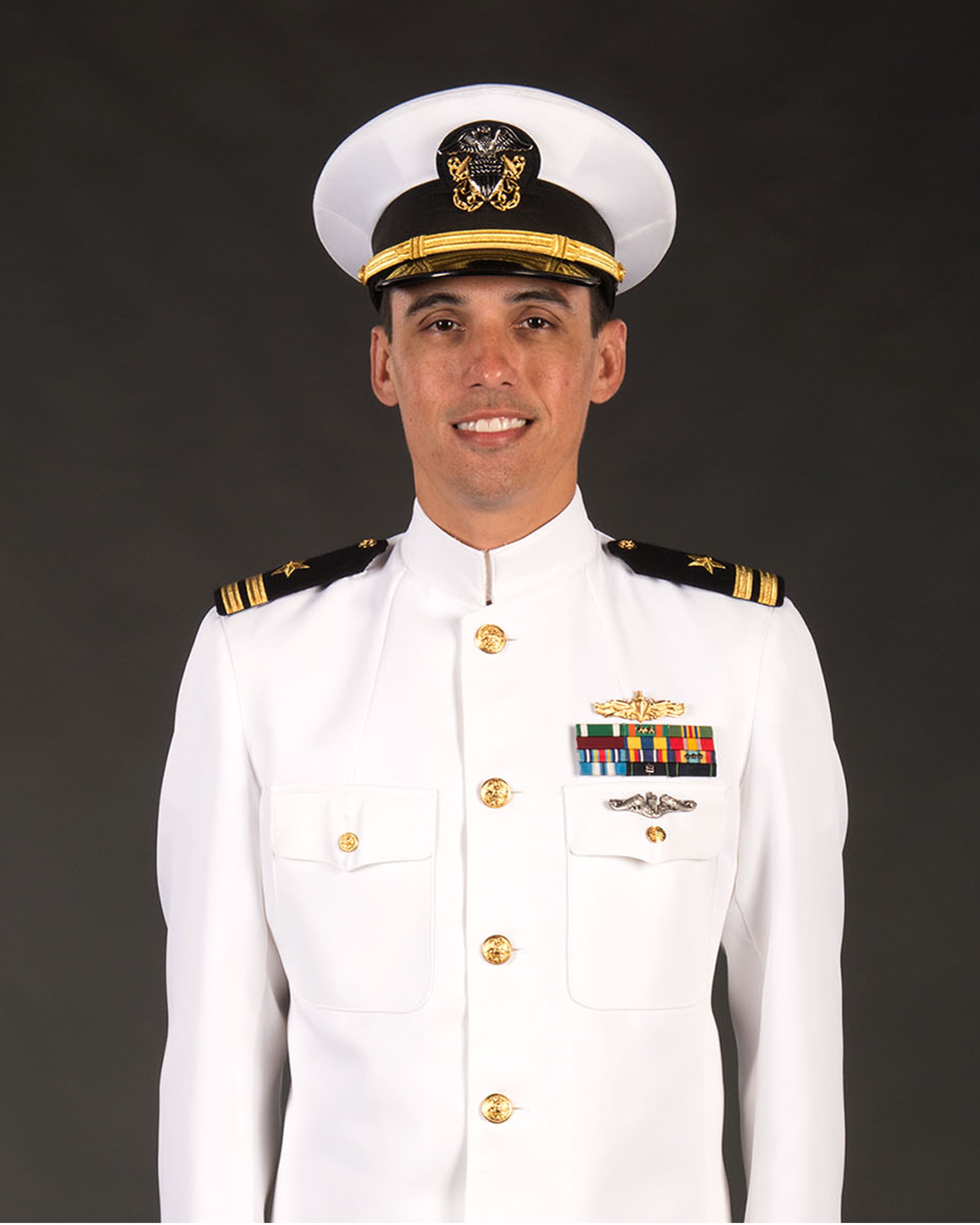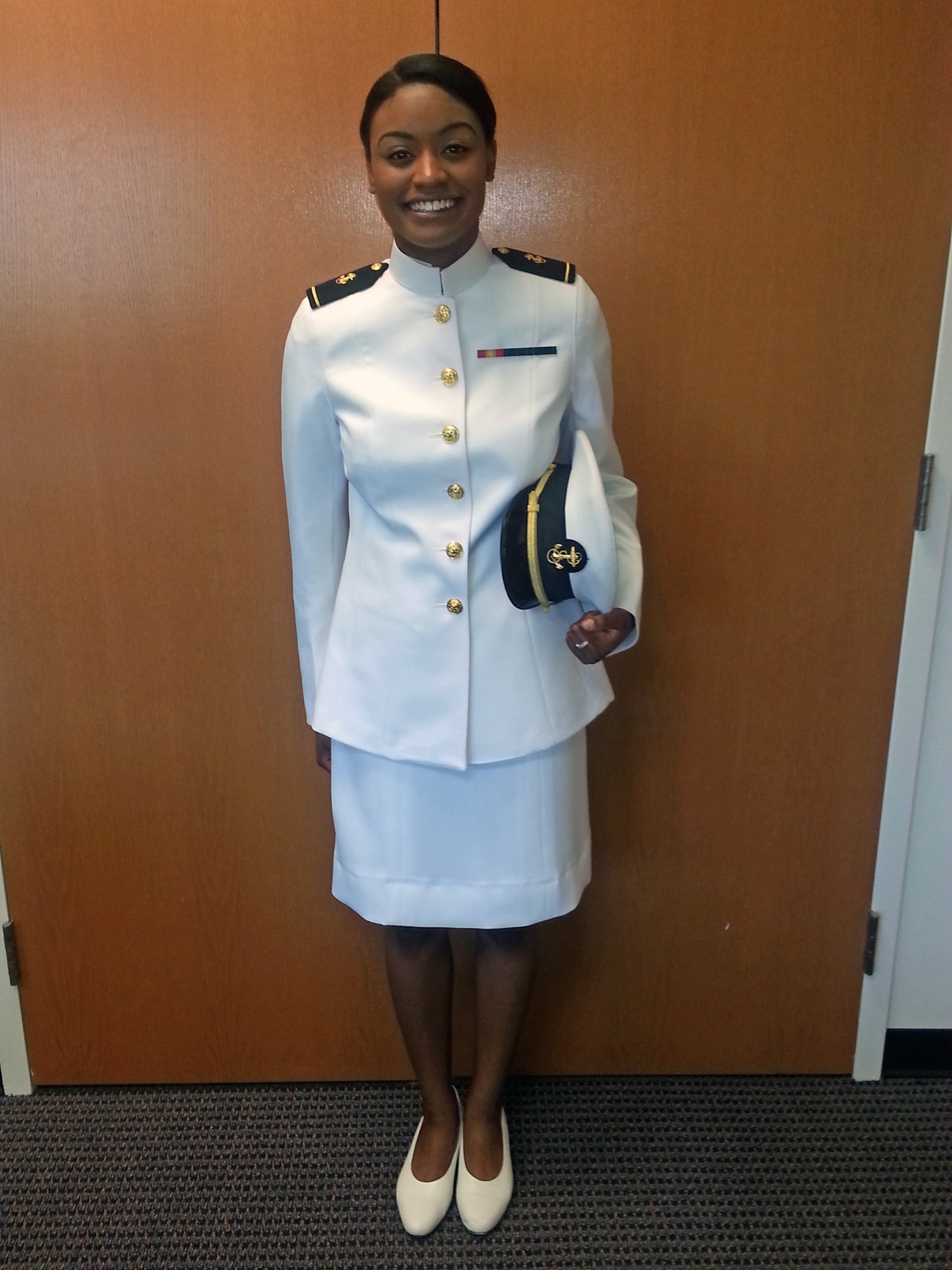More than 200 female midshipmen, chiefs and officers will don the new service dress whites in the first of a series of wear tests slated to last through the summer.
The uniform prototypes have the same high collar common to the male uniform. This includes an improved metal clasp that provides better closure and a more professional appearance. The uniform has no chest pockets, and buttons are smaller yet proportional.
The first wear test will take place at the Naval Academy graduation on May 22. Roughly 200 female graduates and six academy staff members, a mix of chiefs and officers, will take part. The midshipmen will wear their standard cover until they are commissioned, and then will don the combination cap. The active-duty testers will wear the new combination cover, a prototype that closely resembles the male cover but is made with women's head sizes and proportions.
The graduates will provide feedback upon reporting to their first assignment. Since some will go on leave prior to reporting, officials expect it will take about a month to receive all evaluations.
During that time, the Navy will launch a second wear test that will include 20 flag officers and chiefs from Norfolk, Virginia, to Newport, Rhode Island, and from Washington, D.C., to Honolulu.
"We will test the uniform on women of varying body types, who will wear it at different events in different locations," said Cmdr. Chris Servello, spokesman for the Chief of Naval Personnel. The locations run the gamut, from the amphibious assault ship Bataan to Portsmouth Naval Hospital in Virginia. Participants will provide ongoing feedback and give a final report to the Uniform Matters Board by summer's end.

The prototype service dress whites for women feature a high collar, like on men's uniforms. They are tailored for a woman's measurements, providing a more comfortable fit, but at least some wear testers said they seem to be less "flexible" than the old SDWs. They do not have pockets on the hips.
Photo Credit: Navy
Where the program goes from there depends on the results of the wear test. It normally takes 12 to 18 months from the end of a wear test before sailors see uniforms on the shelf.
"We are pushing that process and expect to see uniforms in the exchange and available online in the fall of 2016," Servello said.
"We think we have the 95-percent solution, with feedback from the wear test taking us to the final design," he said. "Changes have been made to the internal structure, the collar height, the shoulder cap and button placement since the initial Naval Academy graduation fittings in November.
Midshipman First Class Adriana Ayala, who was part of that initial fitting, said the new dress whites are "definitely different, nothing like any uniform" currently worn by females. It closely resembles the male version but is well-fitted to the female body, and "it does look very sharp."
"It is comfortable, but definitely not as flexible as the old uniform," said Ayala, a history major from Englewood, California, who is slated to be a surface warfare officer aboard the destroyer Gonzalez in Norfolk. "It's pretty stiff. Maybe it takes some breaking in; it was definitely hard to move our arms."

Marine Col. Roberta Shea, deputy commandant of midshipmen, wears the Corps' version of the dress blues.
Photo Credit: David S. Tucker/Navy
One observation that is sure to make her final analysis is the lack of pockets. She said an inside pocket would be nice to have. The ability for a new officer to help inform the design of a new uniform is not lost on one of the Academy's senior officers.
"Any time you are allowed to have a voice in the future of your service, you get a little excited about it," said Col. Roberta Shea, deputy commandant of midshipmen. She has seen dozens of uniform changes over her career. In fact, she is part of the Corps' wear test of the female dress blues, which includes the iconic leatherneck collar (similar to the so-called mandarin collar on the Navy's service dress whites).
"Everybody has an opinion, and people have strong opinions sometimes when it comes to uniforms," said Shea, who has heard "a wide variety" of thoughts on the new SDWs. Some folks "are not crazy about it," while others beamed when they put the jacket on.
"We are learning a lot," Shea said. "We are learning what people like, and what they don't like, and that's the whole point of having a wear test."
There are always learning curves. For example, the Corps did not provide guidance on ribbon placement for its new female dress blues, so Shea and fellow Marines used the spirit of existing rules to work out the issue as best they could. The Navy adopted current regs for the wear test.

The new women's service dress whites for officers and senior enlisted look very much like the men's uniforms. Both uniforms now feature an improved metal clasp in their collar to provide better closure and a more professional appearance.
Photo Credit: Navy
While uniformity with the male SDW is the primary goal, Navy officials are adamant that women will not simply be issued smaller versions of a man's uniform. That effort will be aided in coming years by an anthropometric sizing correlation study that kicked off in late 2014.
Though the study is not finished and was therefore not considered for changes to the service dress whites, the study will be used to improve the comfort, performance and fit of all uniforms for both genders. The study will measure 4,000 sailors and compare those findings to a 2010 Army study that measured 94 body points on 13,000 soldiers.
The Army study — the first of its kind since 1988 —— combined standard measurements with three-dimensional surface scans of the body, head, face and foot. Army officials found that modern service members are larger with more defined muscle mass, but uniforms were still designed using 25-year-old data.
Some of that data was used to develop a female-specific Army Combat Uniform, the soldier's equivalent of the Navy Working Uniform. The female-cut ACU comes in 13 sizes and boasts more than a dozen upgrades suited to meet the size and shape of every woman. Jackets come in different chest, waist and sweep measurements, while trousers come in different hip measurements.





